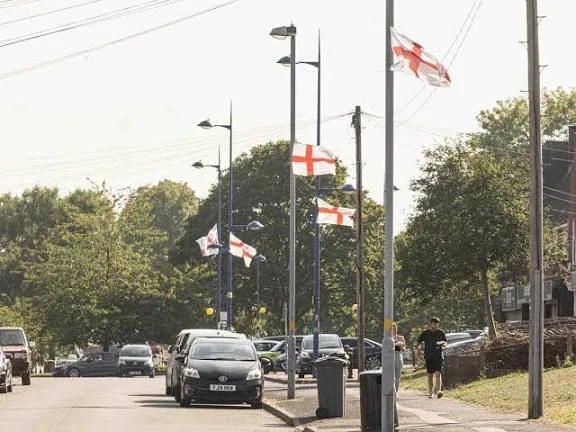Flags on Lamp Posts: Pride, Protest, or Prejudice?
In recent weeks, flags have appeared on lamp posts across Birmingham, starting in Weoley Castle. To some, this might look like a harmless show of patriotism, an expression of pride in community and country. But we need to ask ourselves a harder question: why now? Why has this sudden, highly visible “new” sense of pride emerged at the same time as protests against so-called “illegal immigration”? And why is this conversation so often confused, with refugees and immigrants lumped together as though they are the same?
One of the most damaging trends in public debate today is the deliberate blurring of the line between refugees and immigrants. Refugees are people fleeing conflict, persecution, and human rights abuses. They are legally entitled to protection under international law, most enter the country illegally as for many there is no other option, meanwhile, immigrants are people who move by choice either to work, to study, or to build a better life.
To conflate the two is not just inaccurate; it is dangerous. It encourages resentment towards vulnerable people who need safety, and it feeds into a hostile atmosphere where compassion is painted as weakness. When flags go up in the middle of these debates, it is worth asking: are they really about love of country, or are they a coded message about who belongs — and who doesn’t?
While symbols matter, a flag is never just a piece of fabric; it carries meaning. For many, the sight of a Union Jack brings feelings of belonging and identity. But for many others, particularly in moments like this, it can feel like a claim of ownership over public space, a way of saying: this is ours, not yours.
That is why some local people see the sudden rise of lamp post flags not as a harmless act of pride, but as an act tinged with racism. Whether intentional or not, the context matters. And if that is how part of our community experiences these displays, then we should not dismiss their concerns.
I suppose the real question, then, is not just what do the flags mean to those who put them up, but what do they mean to those who have to walk past them every day?
If we are going to talk about pride, then let’s be honest about who and what makes Great Britain what it is today. Is Britain the story of one people, one culture, or one flag? Or is it the story of many? It is the story of Irish workers who helped build our cities and roads. It is the story of South Asian families who kept shops open through decades of social and economic change. It is the story of Caribbean nurses and Asian doctors who are the backbone of the NHS. It is the story of Polish and Eastern European workers who contribute to industries and services we all rely on. It is also the story of LGBTQ+ activists who fought tirelessly for equal rights, making Britain a fairer society for everyone. That is the real Britain — not narrow, not monolithic, but diverse and interconnected.
So, if lamp posts are to be decorated with flags, why should they only carry one symbol? Why not fly the flags of Jamaica, Pakistan, Poland, European Union and Ireland alongside the Union Jack? Why not add the Pride flag and the Trans flag, as visible markers that everyone belongs here? Surely that would not dilute national pride; wouldn’t it enrich it? It would reflect the truth of our shared society rather than a single, selective version of it.
If local people believe the current displays of flags are being used in a racist or exclusionary way, then silence is not an option. Complaining quietly will not change anything. The only way to respond is through action. One option is symbolic: fundraising to put up more flags, flags that reflect the full diversity of the community. Another is collective: organising community Walks, where residents bring their own ‘different’ flags, their families, and their pride in their identities. Walking side by side, displaying a kaleidoscope of flags, would be a powerful demonstration that this area is for everyone.
It would also challenge the narrative that mainstream media has too often reinforced. Biased coverage from outlets such as BBC have leaned into the framing of “ordinary people standing up against illegal immigration,” while neglecting to show the voices of those who want inclusion, compassion, and solidarity. A public, visible, celebratory act would make that story impossible to ignore.
Flags can be used as symbols of unity or division. Right now, they risk being seen as the latter. But we do not have to accept that. We can choose to take the same idea — visible pride in public space — and turn it into something that reflects all of us, not just some of us. The choice we face is simple: do we allow our streets to be marked by a narrow and potentially hostile vision of pride, or do we reclaim those streets with a celebration of the real Britain — diverse, resilient, and shared? The next step is up to us.

